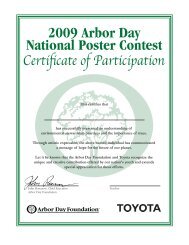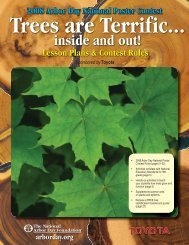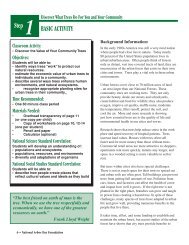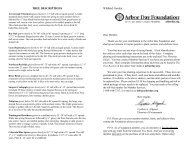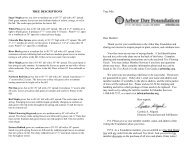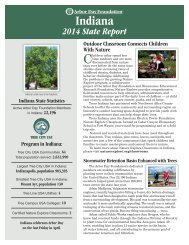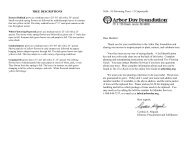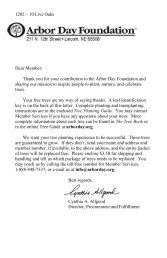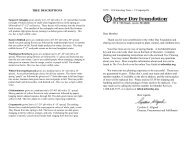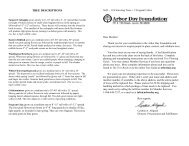Tree Diversity Activity - Arbor Day Foundation
Tree Diversity Activity - Arbor Day Foundation
Tree Diversity Activity - Arbor Day Foundation
You also want an ePaper? Increase the reach of your titles
YUMPU automatically turns print PDFs into web optimized ePapers that Google loves.
Step1<br />
Discover the importance of tree diversity in a community<br />
BASIC ACTIVITY<br />
Instructional<br />
Design a healthy, diverse<br />
community forest<br />
Classroom <strong>Activity</strong>:<br />
• Using available worksheets, students will<br />
design a diverse community forest landscape<br />
plan.<br />
Objective:<br />
• Students will apply knowledge of specific<br />
trees' growth characteristics, landscape<br />
functions, and site requirements as they design<br />
a diverse community forest landscape plan.<br />
Time Recommended:<br />
• One 50-60 minute class period.<br />
Materials Needed:<br />
• Copies of worksheets provided<br />
• Scissors<br />
• Glue or glue sticks<br />
• Ruler<br />
National Science Standard Correlation:<br />
• Design a solution or product in light of the<br />
information at hand.<br />
Common <strong>Tree</strong> Shapes<br />
Sequence:<br />
Assess your students' prior knowledge and awareness<br />
of trees by asking how many different types of<br />
trees each student sees when coming to school.<br />
Record the responses, without comment, on the board.<br />
Ask students how they can tell the different trees<br />
apart. Responses will vary. Some leading questions<br />
to ask could include:<br />
Does the tree have special fruits or seeds?<br />
Does the tree have a unique shape?<br />
Are the leaves broad and flat or needle-like?<br />
Does the tree shed its leaves annually (deciduous)?<br />
What does the bark look like?<br />
Hand out copies of the <strong>Tree</strong> Information<br />
Worksheets to each student. Explain to students that<br />
they are going to create a community forest landscape<br />
plan by selecting trees to "plant" in designated<br />
locations. Knowing how to properly plant a tree is<br />
important, but planting the right tree in the right<br />
place is essential if you wish to enjoy that tree for<br />
decades to come. Explain that in selecting the appropriate<br />
tree for a location there are several important<br />
things to consider.<br />
Concept #1: Without variation, one disease or<br />
insect could destroy all the trees in a community.<br />
Explain that insect pests and disease organisms<br />
can affect almost any tree, but usually these are not<br />
life threatening. Occasionally, a disease or pest will<br />
appear and almost completely destroy a particular<br />
tree species.<br />
For instance, the American elm was once the most<br />
commonly planted street tree in North America. A<br />
fungus called Dutch Elm Disease found its way to the<br />
United States and spread across the nation killing<br />
millions of elm trees and leaving many cities almost<br />
treeless. Planting a variety of trees prevents one<br />
disease from destroying all the trees in a community.<br />
Columnar<br />
Pyramidal V-Shaped Round Oval Weeping<br />
National <strong>Arbor</strong> <strong>Day</strong> <strong>Foundation</strong> •



